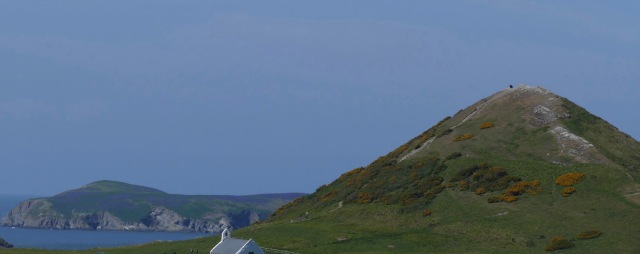Giants lived in Mwnt. They were long-lived and clean limbed and very tall, though they built small with doors more fat and wide. It made them safe, they felt, from the sea-monsters and storms of the Irish Sea.
There were the saints of course. Mwnt beach was a lawn of yellow sand stretched under gnawed-out cliffs beneath the glacial cone of Y Foel. The priests made it a staging post of the bodies of the saints travelling east to their last home at Ynys Enlli, so far away that even on the clearest day a giant stood on top of the mount could not see it. Maybe they were not meant to: after all, they were giants, not worshippers.
Their numbers were dwindling. It was slow but perceptible. The people of Mwnt remained long-lived, often seeing half again of their three-score years and ten, but they were becoming like the rest. Smaller, devout and quarrelsome. At length, Olwen realised there were no others, that she was the only giant left in Mwnt. She asked the travellers who came through, bearing the holy remnants, and heard of no other in the wide kingdom of Dyfed.
Giants stay at home. They gather what they need, or it is brought to them by the wind and the sea and the people. Olwen stood on the top of Y Foel, her red checkered trousers caught by the wind which blew the turquoise cape back from her shoulders and knotted her hair into lumps. She looked down at the little white church and turned to gaze north across the sea towards Eire and Alba. Behind her stretched the fields and walls, the husbandry of the people and to each side of her lay cliffs and cwms.

Striding down the mount, she set off east, towards the dawn. She walked across the field by the graveyard, scattering the sheep until she stood at the edge of the cliff. It was sheer in places, the slate exposed, teeth reaching into the water. At the top, slate melted into tussock grass, gorse, nettles and brambles, vetch, plantain and carpets of bluebells. She laid her great left foot down and created a space, a flat place where the earth took her imprint and made a path for her. She put her right foot down and the same happened, the cliffs of Ceredigion welcoming her tread, opening the way.
She was careful. Those cliffs were steep, and it would be a long fall, even for a giant. She walked and walked. Down into tiny valleys the breeze leapt over but where the sun shone the may was already in full bloom and streams rattled over the rocks. Up to the heights where the tiny leaves of bracken were still squeezed shut like a child’s eyes when the school bell rings, unwilling to waken to the spring. Sea pinks waved gay as the flags of the people and thorns caught in her trousers making her yet more tatterdemalion.
Once she looked back, just once, at the pile of her home and the island beyond it. The path stayed open, marking her passage along the coast, the ups and downs and steeps of it. More often, she looked to her left, out to sea where the gulls rested on the swell. She caught the flicker of dolphins, and people too, in their little boats, hunting the same flashing, silver prey.
Despite her size and the length of her stride this was unaccustomed work and she was slow. Some hours later, as the sun rode high, she reached a flat open headland, the grass cropped fine by the sheep. Overhead the clouds were ragged tails, rough as her hair, showing the wind still blew fast off the sea in the upper air.. Rain would come, but not yet awhile. She walked down and down and down, not just to a stream this time but right to the beach and the small town where people had gathered. Here was a home of the herring fleet where men made boats and women made nets, a humming centre of trade. The air stank of the fish. She saw they had a white church too, home of Cynwyl who they had made a saint. She snorted, shaking the houses lining the clifftops with her surprise. The man had been a cousin of her mother, no more a saint than she was.
Aberporth, they called the little town. Its two beaches became one at the low tide, exposing the small slate cliffs. She sat down on the flat, warm sand and rested for a while. Tomorrow, she would leave again, and continue making her path along the cliffs and beaches of her land.
(Yesterday, four of us did this walk from Mwnt to Aberporth. It’s only six miles but it was a lot of ups and downs. I am burnt down one side from the strong spring sun. This is less than 1% of the magnificent Welsh coastal path.)


Pingback: Calanques, copper and stonechats | Sarah Tanburn